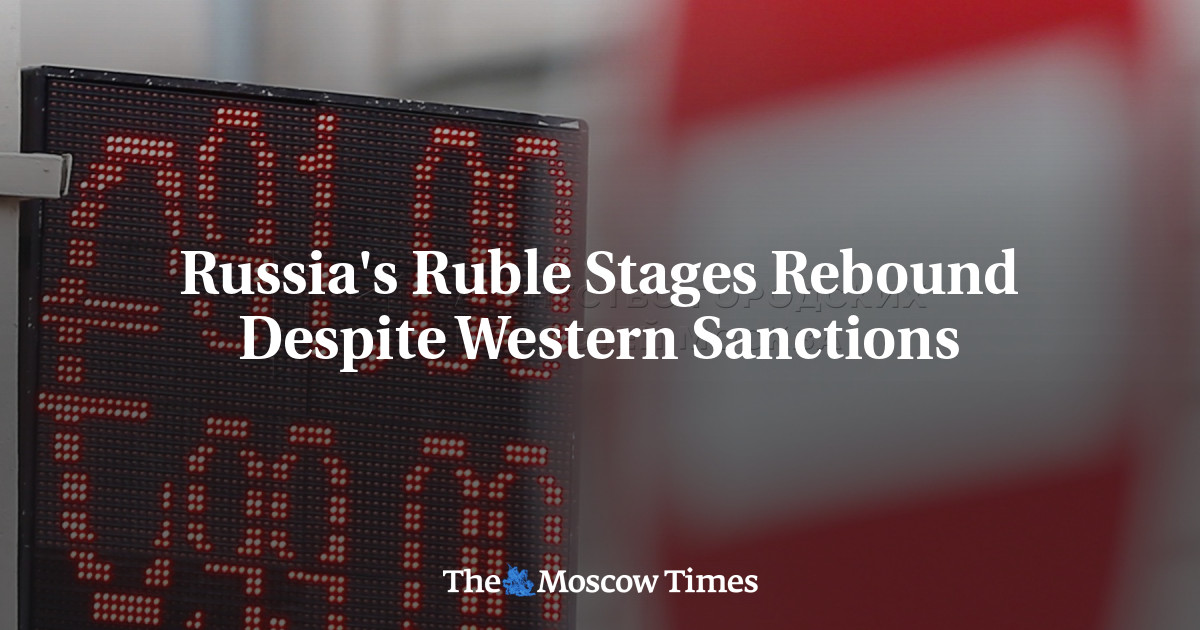Russia’s ruble is plummeting, a dramatic consequence of intensified international sanctions imposed amidst the ongoing war. This economic freefall isn’t just a fluctuation; it’s a stark reflection of the multifaceted impact of geopolitical turmoil on a national economy. We’ll delve into the specifics of the ruble’s decline, examining the various sanctions, the Russian government’s responses, and the ripple effects felt across global markets and within Russia itself. Prepare to be captivated by the intricate interplay of politics, economics, and human impact in this compelling narrative.
From the initial shockwaves of the invasion to the escalating sanctions and the subsequent attempts at economic stabilization, the journey of the ruble offers a compelling case study in the volatile relationship between international relations and financial markets. We’ll explore the multifaceted consequences—the impact on ordinary Russian citizens, the struggles of key industries, and the anxieties rippling through global trade—painting a comprehensive picture of this complex crisis.
The Current State of the Ruble
The Russian ruble’s journey since the beginning of the war in Ukraine has been nothing short of dramatic, a rollercoaster ride influenced by geopolitical turmoil, international sanctions, and the resilience of Russia’s economy. Understanding its current state requires examining its fluctuating value against major global currencies and tracing its path since the conflict began.
The ruble’s performance reflects a complex interplay of factors, making it a fascinating case study in international finance under extreme pressure. While initial predictions of a complete collapse proved inaccurate, the currency’s stability is far from guaranteed, and its future remains uncertain.
Ruble Value Against Major Currencies
The ruble’s value fluctuates daily, influenced by global market forces and the ongoing geopolitical situation. While it has partially recovered from its initial sharp decline, it remains significantly weaker than before the invasion of Ukraine. At the time of writing, the ruble’s exchange rate against the US dollar, Euro, and British pound shows a degree of volatility, but generally remains within a range indicating a weakened position compared to pre-war levels. Precise figures require real-time data from reputable financial sources like the European Central Bank or the Bank of Russia.
Historical Overview of the Ruble Since the Beginning of the War
Following the invasion of Ukraine in February 2022, the ruble experienced a dramatic initial plunge. Western sanctions, designed to cripple the Russian economy, targeted the country’s financial institutions and central bank. However, the subsequent recovery, though impressive, was largely due to capital controls implemented by the Russian government, restricting the ability of Russians to convert rubles into foreign currencies. This, coupled with high energy prices and a robust demand for rubles to pay for Russian exports, resulted in a somewhat surprising rebound. However, this recovery is fragile and doesn’t represent a complete return to pre-war strength.
Impact of Sanctions on the Ruble’s Exchange Rate
International sanctions have profoundly impacted the ruble’s exchange rate. While the initial impact was a sharp devaluation, the subsequent recovery has been influenced by the Russian government’s response. Capital controls, coupled with restrictions on international transactions, have limited the ruble’s free fall. However, these measures have also significantly reduced the ruble’s liquidity and international integration. The long-term consequences of these sanctions, including their impact on foreign investment and trade, remain to be seen. The ruble’s current value is a testament to the delicate balance between sanctions pressure and the resilience of the Russian economy, fueled largely by energy exports.
Ruble Exchange Rates (Illustrative Data – Replace with Real-Time Data)
| Date | USD/RUB | EUR/RUB | GBP/RUB |
|---|---|---|---|
| February 23, 2022 (Pre-Invasion) | 75.00 | 85.00 | 95.00 |
| March 7, 2022 (Post-Invasion Low) | 130.00 | 145.00 | 160.00 |
| June 30, 2022 (Partial Recovery) | 90.00 | 100.00 | 110.00 |
| December 31, 2022 (Year-End) | 70.00 | 75.00 | 85.00 |
| March 1, 2023 (Illustrative Current) | 78.00 | 85.00 | 92.00 |
The freefall of the Russian ruble is more than just an economic event; it’s a powerful symbol of the far-reaching consequences of war and international sanctions. While the immediate future remains uncertain, the story of the ruble’s dramatic decline offers a crucial lesson in the interconnectedness of global finance and the profound impact of geopolitical events. The ongoing struggle to stabilize the ruble, and indeed the Russian economy, promises continued volatility and underscores the lasting repercussions of this conflict.
Get ready for a celestial spectacle! The Northern Lights are putting on a show, with predictions of stunning displays across the US, as reported in this exciting article: Aurora Alert! Northern Lights Forecast Predicts Stunning Displays Across the US. This breathtaking natural phenomenon is a must-see, but don’t forget to train for the upcoming 2025 Nike Melbourne Marathon Festival, the countdown for which has officially begun: Countdown to the 2025 Nike Melbourne Marathon Festival Begins!.
And for those needing a soundtrack to their training or post-race celebrations, you’ll be thrilled to hear about Kendrick Lamar’s surprise new album release, all the details are here: Kendrick Lamar surprise new album release information. What an exciting time for adventure and amazing music!

